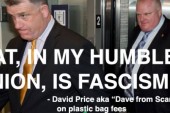
As I mentioned last week, I used to work for Eye Weekly. I was fired in 2005. I also worked for NOW back in 1998. I was fired in 1999, I think it was. But when I worked for them, and before, I thought both were really exciting; fascinating, even.
I still remember reading the classifieds in NOW when I first moved to Toronto for school. Learning the acronyms and argot for their personals was the contemporary version of the hankie code. It took me a while, but before long, I could talk M4M with barely any accent at all.
I still have the letters I wrote to Bill Reynolds asking for a job at Eye after I got fired from Quill & Quire (you’re seeing the trend?), and another one a year or so later to their film editor hoping to bust back into the review biz. The reason I kept at it, and finally got a job there, was that I thought Eye, too, would be an exciting place to work. Neither Eye nor NOW was anything like the Star or the Globe or Maclean’s or anything else in what the current hankie code suggests I call the MSM.
As the years went by, I found myself less frequently excited by either paper, and then, not at all. A tale oft told. But I don’t think it’s me. I think it’s them.
I had long had an inkling that it might not just be me getting older and moving out of the alternative media’s ideal demographic, though I did get fired by two-thirds of what this city had to offer (I left Xtra peacefully), and thought it possible my grudges were muddying my view.
But I took a recent trip through the U.S. Pacific Northwest shifted the balance. I was ambling through the Pike Place market when I saw a pile of Strangers, Seattle’s alt-weekly, edited by sex columnist Dan Savage. I stopped and stared at the cover. It was a drawing (by Jim Blanchard) of Osama bin Laden with a bullet hurtling (complete with going-really-fast-lines) towards his gently grinning head. The headline was “Remember that time President Obama shot Osama bin Laden in the face?”
I was transfixed. It was the week it happened, so of course the media was full of it. But nothing made me want to say fuckin’ A as much as this cover. I liked that he was dead. I liked that it was Obama who did it. I liked what that meant about the Republicans’ lunch and who was, that week and for months to come, eating it all up. And I liked how The Stranger had used their particular format — full-cover picture, as much room as they want for a wordy headline — to such excellent effect. It was bold, it was beautiful, it was specific, and it said Fuck you to several groups and ideologies at once.
Paul Constant’s cover story was secondary to that particular experience, I’m afraid. But when I did read it, it was, pleasingly, the verbal equivalent of Blanchard’s picture.
This was definitely an alternative, from a paper whose editor had successfully crowdsourced a pornographic definition of the name of a U.S. senator, the same one who wrote a book about the glories of open adoption, and who later was open about the fact that he was close to changing his mind on the subject. He’s the same guy who launched the It Gets Better project, which went from YouTube to T-shirts to everywhere else in what seemed liked minutes (I hear Disney’s re-tooling “It’s a Small World” as we speak).
So, The Stranger’s got some good genes. But it doesn’t take a syndicated culture hero to make a good alt-weekly. There’s plenty of proof of that, just not a lot of it recent. And the fact that The Stranger’s still doing it provides at least some evidence that it’s still possible, that media can still be exciting to those looking for perspectives and vocabulary that are still not welcome in the mainstream media no matter how outrageous it gets.
It’s easy enough to see what happened in Toronto. NOW was founded by a bunch of smart, energized young’uns back in the 70s, many of whom are still there, often in the same positions, the owners now wealthy. It’s hard to convince bootstrappers like that to change — they’ve got ample proof that they already have the winning formula. The fact that Eye has now fallen in the field at their Birkenstock-exposed toes won’t have helped matters.
I’m sure NOW’s still exciting to people who have just moved to the city from Tweed, in much the same way the Pride Parade would be. But with its patio guides and restaurant reviews, it’s not nearly the alternative it once was. Its news is still uniformly left-wing, though it’s been so reliable over the decades that its version of left is nearly the same as it was in the mid-1970s. You needn’t read the stories. Just read the headlines: you know what’s coming. None of which is to say it’s not valuable, and that the NOW folk aren’t good at what they do; it just hasn’t kept up with the alternative times; I get the sense it may be an alternative to something that no longer exists.
As far as I can tell, the most engagingly alternative thing about NOW now is Sasha, the sex columnist, who they were wise enough to pick up when Eye dumped her last year.
Eye’s even easier to figure out, and sadder. After almost two decades of actually not being the shills NOW always said they were, their corporate ownership finally shone through. Not that you can blame Torstar, really. Financially, I hear Eye never did much other than tread water. So now we have The Grid. Toronto Life, they figure, is for 40- and 50-something consumers; The Grid is for 20- and 30-something consumers. Technically, I guess that is an alternative.
You could be kind and say they’re a victim of their own success, that their way of looking at music and movies and just about everything other than sex has filtered down, or up, into the mainstream. Ben Rayner at the Star is not substantially different from Eye’s former music guru Stuart Berman, and I can’t think of anything Berman or any of his former music writers did in Eye that Rayner wouldn’t have been able to do in the Star. Dave Morris, Berman’s successor as music editor, tried for a while to introduce new artists and new forms of music to readers — he’s the first person I heard about crunk from, for instance — but for the most part, the paper stayed devoted to its indie rock darlings, and even devoted their final cover to Ron Sexsmith. And ditto, but worse, for NOW, whose 90s version of being an alternative music source, as I recall, was being the only kid on the block who refused to write about any music that was not rock and/or roll. Fortunately, NOW‘s music coverage is more eclectic and forward-looking today.
It all comes down to something that’s not at all specific to alternative media. As in politics, you can have some form of success trying to second-guess your audience and giving them what you figure they want. But the only successes that matter tend to come from places that figure things out for themselves, apply some craft in how they compose their thoughts, words and images, and then offer it up. If they’ve done it right, their audience will follow along and possibly take it further. If they fail, intellectually, or in their craft — a big part of which is concerned with appealing to audiences — then they’ll fail commercially. But with those demography chasers, those two brands of failures are not linked, and even when they have very little going on in the way of smarts or craft, they can continue to exist on life support, sometimes very well, getting all ambulatory with their IV drips and colostomy bags, and carry on as long as any comatose patient in a vegetative state.
There’s still a need for what The Stranger, at least occasionally, does. And I don’t mean that in a she’s-still-got-some-life-in-’er-yet way. I mean permanently. To say I’m a big fan of online media is like saying I’m a big fan of indoor plumbing. Of course I am. It can do loads of things print and broadcast can’t. But it won’t let you stumble upon things, like I did with The Stranger in the market, unless you actually sign up at StumbleUpon. I didn’t have any friends who recommended The Stranger to me that week. I hadn’t subscribed to any feeds that would have brought it to me. It was a random intersection in physical space. Back in print’s heyday, serendipity was among the least of its virtues. But now it’s clear that nothing else can yet reproduce it.
But it’s those words and images that make the serendipity worth something. I’ve not done an exhaustive survey of The Stranger, and any Seattle native reading this might take great umbrage with all this praise. But, at least in that one issue, for the week of May 4-10, they knew who they were, what they thought, and how to talk to who they were talking to. They were intelligently, irreverently alternative. We could all use a lot more of that kind of Stranger in ourlives.















